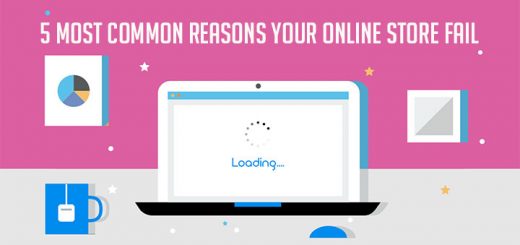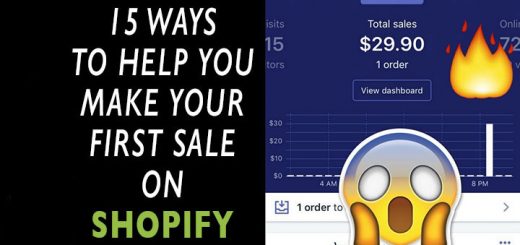8 Long-Term Strategies to Generate Sales Online
All of the strategies in previous article are relatively small projects that can start boosting your online sales fast. But to build a more sustainable eCommerce business that gets strong results long term, there are a few additional eCommerce marketing strategies to include in your efforts.
1. Check your analytics to review what’s working now
If your eCommerce site has been up for a little while already, then you can learn a lot about what works well for your audience by looking at your own analytics. Check Google Analytics to see:
- What traffic sources are sending the most visitors to your site
- Which sources send the highest-converting visitors
- Which send the visitors with the biggest order sizes, or those that become repeat customers
- What pages people visit the most
- Which pages most consistently lead to sales
- Which pages lead people to stick around and visit other pages
- Which lead to other types of conversions such as content downloads or email signups
Google Analytics is full of data that helps you understand how your customers learn about you, which of your marketing efforts increase eCommerce sales, and which customers are the most valuable to your business. That information will help you shape a more successful long-term marketing strategy designed to attract the right visitors.
2. Do a website audit
A website audit is a big project, but it will help you suss out which parts of your website are effectively doing their job, and which aren’t. Many eCommerce sites have pages that get very little traffic, or fail to get visitors to take any meaningful action. And sometimes, the structure or design of your website can make it harder for visitors to find what they’re looking for.
With a thorough website audit, you’ll identify opportunities to improve your website by dropping low-performing pages, combining them with other related pages, and optimizing successful pages to perform even better.
In addition to tightening up and improving what’s already there on your website, a website audit leads to a deeper understanding of what your audience likes and how they behave—insights you can then apply to your strategy moving forward.
3. Do customer UX testing
You’ll never quite be able to see your website the way a customer does. You’re just too close to it. The only way to find out if your eCommerce store is intuitive and easy to use for customers is to give them the chance to test it out directly. Enlist some customers to help you out with UX (user experience) testing.
Have them try out different actions, seek out specific products, and go through the checkout process. Ask them for feedback on the overall experience, and to take note of anything about it that was inconvenient or difficult. Then put that information to use by making updates to the website to improve the customer experience.
4. Improve your on-site SEO
Search engine optimization (SEO) is a strategy for increasing the chances of your website showing up on the first page of search results in Google and other search engines. eCommerce SEO is a long-term project. It takes time to start showing results. But once you manage to claim some of those top spots, it will send relevant traffic your way for weeks, months, or years to come.
The easiest part of SEO is on-site SEO. It includes a few main steps:
- Performing keyword research and picking a target keyword for each page on your site
- Optimizing each page for your target keyword by incorporating it naturally into the copy and headings on the page, as well as the relevant meta tags
- Making sure your website has a fast loading time
- Creating a mobile friendly website, if you haven’t already
- Investing in an SSL certificate for greater security (and because Google likes secure websites)
For most eCommerce sites, on-site SEO won’t be enough on its own to start ranking. But it’s a good basis to build the rest of your SEO strategy on.
5. Invest in building your social following
Social media gives you a way to connect directly with your potential audience. But your social posts won’t even be seen unless you manage to build a following. Determine which social platforms make the most sense for you to prioritize based on where your audience spends their time. For example, does your target audience spend the most time viewing Instagram ads, or do they prefer Facebook? Decide, then develop a strategy to start actively posting and interacting with relevant accounts in your space.
Consider joining Twitter chats, or jumping into conversations you see happening on LinkedIn, and creating a Facebook group. To speed up the process of gaining followers, invest in social advertising. It’s the easiest way to reach people that don’t follow you yet.
6. Increase your content marketing efforts
Content marketing is another important strategy for SEO, as well as a way to build relationships with the people in your target audience. By creating high-quality content on topics they care about, you:
- Prove your value and knowledge to your audience
- Ensure your website will show up for more relevant searches in Google, increasing awareness of your online store and the number of visitors
- Give visitors a reason to sign up for your email list, to see more of your content
- Build trust in visitors who will then be more likely to choose you when they need one of your products
Content marketing takes time to do well, but it can be a powerful strategy for differentiating your brand from competitors in your space, driving more traffic to your website, and gaining more trust from your audience. To get the best results, make sure all your content is optimized for search.
7. Try out different content formats
Most content marketing efforts start with a blog but consider if your audience will appreciate other content formats as well. Experiment with video, audio, or long-form pieces like ebooks. You may be able to gain a larger following and reach new people by choosing a format a certain segment of your audience is more likely to consume.
For each new format you try, collect data on how well it’s working so you know if it’s worth the investment to continue.
8. Focus on customer retention, not just acquisition
Gaining a new customer is hard. Keeping one is comparatively easy. In your strategy to increase eCommerce sales, consider how to encourage repeat purchases. How do you give customers every reason to come back and choose you again?
Part of that is making sure your products are high quality. Part of it’s providing exceptional customer service any time a customer has a problem or question. And part is being proactive about reminding them you exist.
Send emails checking in and offering special deals. Consider starting a loyalty program to reward them for spending more with you. And make it clear every step of the way that you value them.
Source: Hostgator’s Blog








